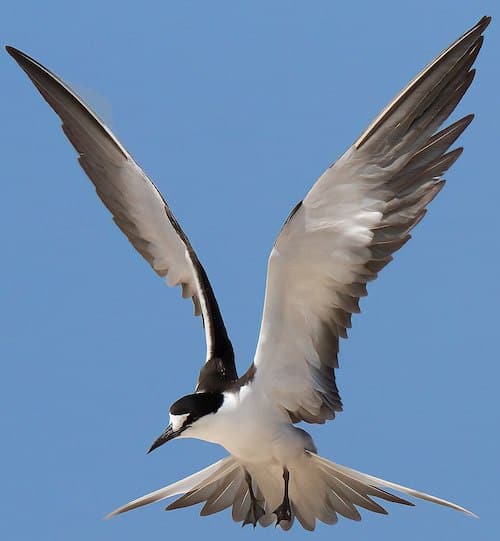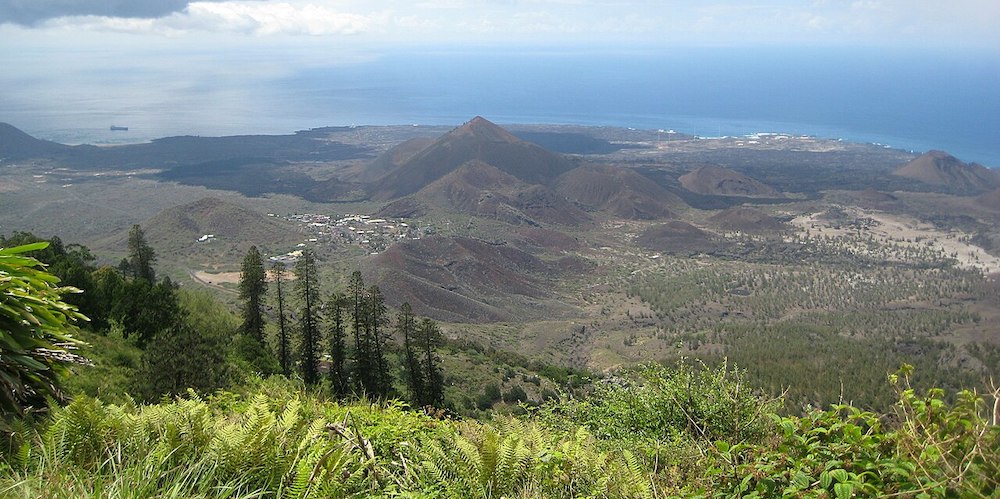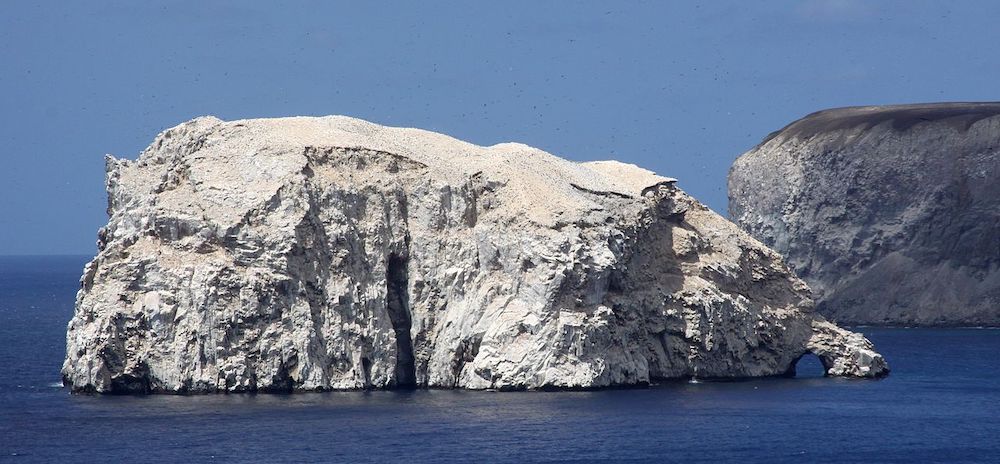Ascension Island

Ascension Island is an isolated volcanic island, 7°56′ south of the Equator in the South Atlantic Ocean. It is about 1,600 km from the coast of Africa and 2,300 km from the coast of South America. It is governed as part of the British Overseas Territory of Saint Helena, Ascension and Tristan da Cunha, of which the main island, Saint Helena, is around 1,300 km to the southeast. The territory also includes the sparsely populated Tristan da Cunha archipelago, 3,700 km to the south, about halfway to the Antarctic Circle. The main island has an area of approximately 88 Km2 (34 square miles). A volcanic peak rising from 100 kilometres west of the Mid-Atlantic Ridge, much of the island is a wasteland of lava flows and cinder cones; forty-four distinct dormant craters have been identified. There are less than a thousand people living on the island, mostly in the capital Georgetown.
The island is the location of RAF Ascension Island, which is a Royal Air Force station, a European Space Agency rocket tracking station, a British-American signals intelligence facility and the BBC World Service Atlantic Relay Station. The island was used extensively as a staging point by the British military during the Falklands War. Ascension Island hosts one of four ground antennas that assist in the operation of the Global Positioning System (GPS) navigational system (the others are on Kwajalein Island, Diego Garcia, and Cape Canaveral). NASA operates a Meter Class Autonomous Telescope (MCAT) on Ascension Island for tracking orbital debris, which is potentially hazardous to operating spacecraft and astronauts, at a facility called the John Africano NASA/AFRL Orbital Debris Observatory.
Ascension has a hot desert climate and the temperatures at the coast average from 28 °C and about 5 °C cooler at the highest point. Rain showers may occur at any time during the year, but tend to be heavier between June and September. Although the island is in the tropical zone, average annual rainfall is very low.

View from Green Mountain – ©LordHarris, CC BY-SA 3.0 via Wikimedia Commons
Portuguese explorers released goats in the 1500s, which ate many species to extinction. The later introduction of rabbits, sheep, rats and donkeys, and over 200 imported species further marginalised the original flora. By the middle of the nineteenth century he island was barren with few plants. However, non-native trees and bamboo were introduced and Ascension Island’s Green Mountain is now one of the few large-scale planned forests, and is gradually growing with each year. Non-indigenous plants teem there, and the crown of Green Mountain is a lush halo of bamboo. Flanking one side is a large stand of tall Norfolk pine, trees planted by British mariners, which were to have been used as replacement masts for sailing ships. Two decades ago Green Mountain National Park was declared.
A variety of mammals have been introduced: donkeys, sheep, cats and rats among others. Reptiles consist of two species of lizards. The largest native land animal is a land crab Johngarthia lagostoma. The protected green turtle is perhaps the most notable of the endemic fauna, coming ashore to lay their eggs on the beaches from November to May.
Birding Ascension Island
Ascension Island is an isolated volcanic island in the equatorial waters of the South Atlantic Ocean, around a thousand miles from the coast of Africa and 1400 miles from the coast of South America, which is roughly midway between the horn of South America and Africa. It is primarily a military base, but access has recently improved and the island makes a fascinating destination for seabird enthusiasts.

Boatswain Bird Island – ©Drew Avery, CC BY 2.0 via Wikimedia Commons
On land are found such non-native birds as canaries, francolins, mynas, sparrows, and waxbills. The islands used to be home to many breeding seabirds; most are now all but extinct on the main island, and the main breeding site is on nearby cat & rat-free Boatswain Bird Island. Over 10,000 birds breed on this tiny island, which is home to Ascension Frigatebirds, Red-footed, Brown and Masked Boobies, Red-billed and White-tailed Tropicbirds (known as Boatswain Birds), and petrels. The Sooty Tern, known locally as the Wideawake Tern because of its distinctive call, is the most common breeding seabird on the main island, nesting in great seashore lava ‘fairs’ and the airport is named after it. Sadly, the Ascension Rail is extinct.
However, a campaign started two decades ago by the RSPB has now eradicated feral cats from the main island and seabirds are once again beginning to nest there. The whole island has been declared an IBA. The seas around have been declared a marine reserve.
-
Number of bird species: 102
(As at August 2024)
Number of endemics: 1 Breeding Endemic
Ascension Frigatebird Fregata aquila
-
Avibase
PDF ChecklistThis checklist includes all bird species found in Ascension , based on the best information available at this time. It is based on a wide variety of sources that I collated over many years. I am pleased to offer these checklists as a service to birdwatchers. If you find any error, please do not hesitate to report them. -
Wikipedia
Annotated ListThis list of the bird species recorded on Ascension Island includes a total of 102 species. Ascension Island is an isolated volcanic island, south of the Equator in the South Atlantic Ocean. It is about 1,000 miles (1,600 km) from the coast of Africa and 1,400 miles (2,300 km) from the coast of South America. -
eBird
PDF ChecklistThis checklist is generated with data from eBird (ebird.org), a global database of bird sightings from birders like you. If you enjoy this checklist, please consider contributing your sightings to eBird. It is 100% free to take part, and your observations will help support birders, researchers, and conservationists worldwide.
-
A Guide to the Birds of St Helena and Ascension Island
| By Neil McCulloch | RSPB | 2004 | Paperback | 92 Pages, Colour Illustrations | Out of Print | ISBN: 9781901930467 Buy this book from NHBS.com -
St Helena and Ascension Island: A Natural History
| by Philip & Myrtle Ashmole | Anthony Nelson | 2000 | Hardback | 475 pages, 32 pp colour illustrations, line drawings, maps, diagrams, cased | Out of Print | ISBN: 9780904614619 Buy this book from NHBS.com
-
African Bird Club - Ascension Island
WebpageLying in the equatorial South Atlantic, Ascension Island is a UK Overseas Territory and a dependency of the "neighbouring" island of St Helena. Although it is primarily a military base, access has recently improved and the island makes a fascinating destination for seabird enthusiasts...
-
Ascension Island Ocean Sanctuary
Observatory WebsiteSatellite ViewGiven Ascension's globally significant marine biodiversity, the RSPB is calling for the creation of an Ocean Sanctuary around the island to protect its rich waters. This is one of the only opportunities for a large-scale and fully-protected marine area anywhere in the tropical Atlantic. Unlike the Indian and Pacific Oceans, the neglected Atlantic currently has no large and fully-protected marine reserves. -
IBA Boatswain Bird Island
Observatory WebsiteSatellite ViewBoatswain Bird Island, also spelt Boatswainbird Island, is a small island some 270 m off the east coast of Ascension Island in the South Atlantic Ocean with an area of approximately 5.3 ha (13 acres). It is administered from Georgetown on Ascension, which is part of Saint Helena, Ascension and Tristan da Cunha, an overseas territory of the United Kingdom. Boatswain Bird Island should not be confused with the nearby, much smaller, Boatswain Bird Rock. The island has been identified as an Important Bird Area (IBA) by BirdLife International as a breeding site for seabirds. Birds for which the IBA is significant include Madeiran storm petrels (1500 breeding pairs), red-billed tropicbirds (500 pairs), white-tailed tropicbirds (1000 pairs), Ascension frigatebirds (6000 pairs), masked boobies (1300 pairs) and black noddies (5000 pairs).
-
eBird
SightingseBirding This Month
-
BirdQuest
Tour OperatorATLANTIC ODYSSEY – South Georgia, Gough, Tristan da Cunha, St Helena, Ascension and Cape Verde Islands, with Antarctica Extension -
ORNIS Birding Expeditions
Tour OperatorJoin us on one of the best seabird cruises in the world! This is sure to be an exciting time on the ocean, full of laughs and excellent birds.
-
2018 - Laura Shearer
ReportIn 2018, I got my dream job as a Seabird Scientist for the Ascension Island Government. The photo on the right shows an adult Sooty Tern, a species which nests on the island.

